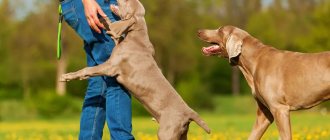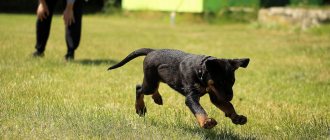Often, pet owners are faced with a situation where the animal does not react at all to a stranger. It is undoubtedly good when it is possible to live in an apartment. But if you are the owner of a large private house, such a dog will not be a guard or assistant. In this situation, the animal must be taught to react to strangers. Many people ask: “How to make a dog angry at strangers?” Of course, the best way is to contact a trainer, but this is not always possible. In this article we will look at different options.
Who is the head in this house
Before you begin training with a German Shepherd, you need to learn the basics of its psychology. Dogs are pack creatures, they have a leader. In a home environment, this position should be taken by the owner. A leadership position does not imply cruelty, but requires obedience. What does it mean? Any dog, especially a guard dog, will try to dominate its owner even in a game:
- snatch the toy from his hands;
- put your paw on it like a master;
- to get ahead on a walk, “leading the owner.”
A guard dog should not be allowed to do this. You will have to patiently wean your pet off being “above the owner.”
In order to control your dog, you yourself must be in a calm and confident state, since the animal is sensitive to the mood of the owner.
When you pick up the leash, you should feel calm and confident: this is the most important factor in controlling a dog.
By sensing your strong energy, the dog will be more manageable. Conversely, when you are irritated or angry, the animal will act nervous or fearful.
Bow
A body position that pets often adopt on their own when stretching or playing with their relatives. The dog that follows the command stands on its hind legs and lies on its front legs. The starting position is at the left foot. We step on the leash with our left foot, and with our right hand we move the treats away from the nose, forward and down. We provoke the pet to lie down without giving the command “Lie down”. As soon as the ward begins to stretch out his front paws, we put our left hand under the stomach, restraining the reflex forward movement, and give the command “Bow.” At the initial stage, even a slight tilt of the dog’s body is considered successful execution of the command.
Growing a Defender
Everyone decides for themselves how to turn a good dog into an evil one and whether the owner and the dog himself need it. After acquiring a puppy, the owner begins to become interested in training and raising the future guard of the acquired property. But a pet less than 6 months old needs, first of all, full care, walks and active games. During this period, he should not be prohibited from communicating with other people; this quality helps him quickly adapt to new conditions, so it is pointless to demand that the baby follow commands.
When the dog turns 1 year old, it will already have learned basic commands and will bring toys to its owner, as well as walk next to him on walks. However, the animal does not yet understand that strangers can pose a threat to its owner. The person’s task at this stage is to instill self-confidence in the dog, maintain good physical shape, and teach simple commands.
A dog that has reached the age of one and a half years is ready for training. First you need to teach him the command “Alien!” and ensure that the dog barks at strangers strictly on the orders of the owner.
Don't forget to warn your neighbors and friends not to play with the animal; ideally, they should not maintain an acquaintance with your four-legged guard. If a pet on a walk wags its tail when meeting a stranger, experienced breeders recommend calling him by name and quickly walking away in the opposite direction. The dog will certainly forget about strangers and follow the owner. Professional dog handlers know how to make a dog angrier. To do this, they exercise the animal in a protective suit, using a stimulus, the pet’s reaction will follow immediately, but this experiment is not safe and is carried out in special animal training centers.
Some useful tips for pet owners
When understanding the issue of training, you need to know several important points and strictly observe them:
- All dogs, without exception, begin to bark or squeal when a stranger appears. At this moment, loudly say the phrase “Guard!” or any other word that you choose for the command, and reward the animal with affection or tasty treats.
- The main thing is not to scare the puppy, so that in the future he does not react to strangers with fear, for example, by huddling under the table.
- Do not yell at your pet, and especially do not use aggressive methods.
- After teaching your dog to vocalize, don’t forget about the “Fu!” command. Otherwise, the animal may bark for hours.
- Never hit an animal; these methods are unacceptable for the owner.
Many people ask the question: “How to make a dog angry at strangers (shepherd, pit bull, boxer)?” After all, these breeds are a priori fighting ones. You need to act with them in the same way as with dogs of other, calmer breeds. But mistakes cannot be made, otherwise the situation may get out of control.
When does a German Shepherd puppy start barking at strangers?
The good-natured disposition of a German Shepherd should not confuse the owner if the animal is not yet 6 months old. The joyful puppy does not bark at strangers yet only because of his age. The first signs of a guard dog may appear at six months or a little later. An experienced instructor will tell you at what age to start instilling watchdog qualities in your German Shepherd puppy. As a rule, we are talking about 9-12 months. If you start training your dog too early, there is a high chance of breaking his psyche. And what an uncontrollable aggressive German Shepherd is, it’s better not to know at all.
If you want to raise a dog who is distrustful of strangers, then during puppyhood you should keep him from communicating with strangers, but this must be done subtly. You can’t shout “Ew” to a puppy if he starts playing with a person, just switch the dog’s attention to yourself by calling him and leave. The puppy will follow you. This is the only thing you can do without disfiguring your pet!
Protection from yard dogs
Owners of four-legged friends are also interested in the question of how to make a dog angry at other people's dogs. After all, while walking in parks, you can meet flocks of stray animals. Remember, a pack will never attack a person if there is a dog next to him.
The main thing is not to get confused at this moment, assess the situation and clearly say the command: “Face!” The animal will burst into loud barking, after which the dogs should run away.
It is inhumane to deliberately set animals against each other. Also remember that stray dogs may have rabies.
If after reading the article you still have a question: “How to make a dog angry at strangers?” — it’s better to contact an experienced dog handler for an answer. He will help you raise the animal correctly.
Source
The main causes of aggression in dogs
There is nothing wrong with aggression as such. This is an instinct that helps animals protect themselves, territory and offspring.
In some breeds, anger is more pronounced. These include service, guard, fighting and hunting dogs. In such pets, aggression towards strangers and suspicious people is deliberately caused and trained.
But in any case, the dog’s behavior must be controlled. He can be angry when needed. And under no circumstances should you rush at the owner, household members, other dogs, pets or passers-by.
Another thing is unmotivated, unwanted aggression. It develops due to:
- violations of selection rules
- when animals are thoughtlessly crossed without taking into account breed and genetic characteristics and the result is a dog with unpredictable behavior;- poor maintenance
- insufficient nutrition, constant stay in an enclosure or on a leash negatively affect the psyche;- improper upbringing
- lack of socialization, training, established rules of behavior.
A lack of upbringing also includes permissiveness, when the owner indulges all the whims of the pet and automatically takes a lower place on the hierarchical ladder.
Sometimes systemic pathologies become the causes of sudden aggression. The dog is in pain, and she transfers her anger to those around her.
It is important to understand that behavioral problems in dogs develop due to the fault of the owner. Only in 1% of cases can aggression be conditionally attributed to genetic and congenital mental abnormalities.
How to teach a dog any skills
A German Shepherd puppy must first be raised with love and care, and then begin training. Desired skills must be reinforced, and for misdeeds scolded, but not beaten. It often happens that a young German shepherd snapped at someone in the family, and the owner was touched by this: this is what a “proper” angry dog is. This cannot be allowed.
The animal should not show aggression towards family members, especially if you want to raise a guard.
A sharp “Ugh” immediately after the action and a light spank, but not a spanking, will show the dog that this is unacceptable.
Encouragement of some action for an animal - affection or something tasty. Teach your pet to follow general commands first:
- "To me";
- "Sit";
- "Near";
- "Ugh".
A general training course is required before training in protective guard service. You cannot “harass” a puppy at a young age, otherwise you will end up with an uncontrollable monster. An adequate and obedient animal, in which guard qualities are inherent by nature, will itself begin to protect its owners and guard the house.
Train a dog to be mean to strangers
Sometimes it is necessary to teach a pet to be angry towards strangers, and also to teach it to bark at strangers. Such methods are used by the owners of private houses and various enterprises where strangers may enter. When a dog has close contact with its owner, sometimes there is no need to cultivate anger. But in most cases, owners turn to a dog handler for help. Only a specialist can help set up training correctly.
Before this, the dog handler must warn that such a command can be dangerous for people around him, that you need to understand the seriousness and know how to pacify the dog. You need to teach an animal to be angry towards strangers from a very early age. By the age of 4 months, the dog should already know the commands “fu”, “come to me”, “stranger”. With the help of a dog handler, you will teach her to be aggressive when you order her. By teasing the dog and catching it, the dog handler will show by his own example that a stranger is dangerous and that action must be taken immediately.
After such activities, you need to behave calmly and restrainedly, praise your pet and give various treats. An experienced trainer will teach you how to develop anger and be wary of strangers after just 5-7 lessons. The main thing is to deal with aggression correctly and quickly calm the animal after such actions.
Secrets of proper training
Training a four-legged prankster is a rather difficult process that requires attention and patience from the owner. It is better to achieve what you want with the help of persuasion and bait, completely avoiding physical coercion or violence. You cannot raise your voice or shout, so as not to frighten the dog; negative words should be replaced with softer ones. For example, if your pet does something wrong, you shouldn’t say “Bad!”, it’s better to say “Oh!” or something similar. The dog must be trained by the same person - either a family member or a specially invited specialist.
One of the main conditions for successful training is the ability to stop in time, giving the dog a rest. The pet should perceive the entire process as a game, and not a grueling chanting of commands. For every success, even a small one, the dog should be praised, combining stroking and a tasty treat. In this way, the owner will establish a strong connection between himself and the pet and establish a high level of mutual respect. Having learned several commands, do not forget to repeat them constantly - this is an excellent help for new tricks.
Watch your dog closely: if he is hesitant to follow commands, he may be afraid of you or your judgement. Bring more love and affection into your animal's activities and daily life, making him more trusting and open.
At what age should I start?
There are two stages of training your beloved pet: at the age of 1 to 3 months and from 4 months onwards. First, the puppy needs to be taught to follow simple commands - to develop an instinct of obedience to the owner. The simplest of them: response to a nickname, accustoming to an individual place, prohibiting words, the command “give”. It is much more difficult to train an adult dog that has not undergone preliminary training, but the task is quite achievable. Regardless of the duration of training, you can begin training to protect yourself from strangers only after achieving complete mutual understanding and obedience of your pet.
Breeds that are easy to train:
- Border Collie;
- German Shepherd;
- Retriever;
- Poodle;
- Rottweiler;
- Sheltie.
Difficult to train:
- Afghan Hound;
- Chow-chow;
- Bulldog.
How to stop a German Shepherd from being afraid
A German Shepherd puppy may be shy from childhood or from improper upbringing. Your pet may be afraid of people, dogs, loud noises, or anything new. For a watchman, cowardice is a completely inappropriate character trait.
If your German Shepherd is afraid of other dogs
A dog's fear of its relatives is associated with insufficient socialization. The pet should not be kept in complete isolation. Since childhood, he must communicate with other dogs under the control of the owner. Let the baby have play partners; this will not affect his working qualities.
If a shepherd puppy has already been frightened by another dog, then this is not a reason to deprive him of the company of his own kind. There are fun, playful dogs that can help your pet regain its confidence. When you need to establish a good relationship with a specific pet dog, agree with its owner about going for walks together. Don't bring your dogs nose to nose, but walk with them on leash parallel to each other. Dogs should move in the same direction, but on opposite sides of you for safety. If you and the owner of a cocky dog calmly walk side by side and have leashes in your hands, then soon the animals themselves will get used to this rhythm and begin to treat each other more friendly.
Attention!! Dogs should not be led towards each other, only side by side. This will work if your dog’s offender is a dog with a healthy psyche, and its owner is an adequate person.
If your German Shepherd is afraid of people
There is a category of dogs in which the appearance of a person causes panic. As a rule, this is due to some kind of psychological trauma or overly harsh upbringing of the puppy. A cowardly German Shepherd is usually afraid of certain people, these could be:
- men in work clothes;
- Small children;
- women with strollers.
The animal experiences fear of that group of people with whom it has painful memories.
You can only remove cowardice from a dog who completely trusts you. Find out which object causes a negative reaction in the animal and start working. It is best to contact a competent dog handler, but if this is not possible, you will have to do it yourself. The peculiarity of working with fears is that here the dog cannot be punished at all: it is already intimidated. Use basic commands such as “Sit” or “Down.” If the German Shepherd performs them perfectly, then you can start working on the result. Agree with the person who causes fear in the animal to come within a certain distance of the dog. If she becomes anxious, give her the Sit command. If the dog has calmed down, reward it, but do not reduce the distance between the pet and the frightening object.
Suppose there are 10 m between objects. The dog “tolerates” the stranger, but glances in his direction. Give her familiar commands and reward her if she doesn't run away. Don’t give her excessive load, don’t reduce the distance, let her get used to it. If the dog bolts, stop rewarding, but do not punish. Carry out such exercises, gradually increasing the time the stranger stays and slightly reducing the distance. Don't try to do this quickly; it may take more than one week.
If your pet is afraid of firecrackers
Fireworks and explosions are a real disaster for the owners. Most pets go missing during the New Year holidays. You need to get used to noise effects gradually with an instructor.
Independent exercises should be carried out while keeping the dog on a leash. Before you start training, try to get the dog to run and have little strength left. Take the animal on a leash and create a noise effect. Start with small balloons, later move on to firecrackers, which must be thrown one at a time to a safe place. Remember that your emotions are transmitted to the dog. Take a few deep breaths to calm down and poke the ball. The dog will twitch, but will not be able to escape. Give her a familiar command or distract her with a toy. If the dog calms down, give him a treat.
If you find fireworks at home, the best reaction to it is the absence of any reaction. Take a few breaths and exhale and bring yourself to a calm state, setting an example for your pet. Typically owners make the following mistakes:
- they begin to feel sorry for the dog;
- wailing over a frightened puppy;
- shouting at a German Shepherd;
- petting a shaking dog.
You should not pet a frightened dog, as this is a positive stimulus for behavior. By doing this, you reinforce the dog's unhealthy reaction, and screaming and hysterics can worsen the situation. It’s best to continue doing household chores, pretending that fireworks are normal. This will most likely calm the dog down.
Your puppy only knows what you teach him
It is important to remember that everything you teach your puppy now will be part of his normal behavior in the future. So when you play with your puppy, try to think of him as an adult dog and evaluate whether his behavior is acceptable or not. If during play he begins to growl, tries to bite the hand holding the toy, or chases the child, stop the game immediately and leave, taking the toy. He will soon understand why the fun ended and will henceforth avoid the behavior that caused such a reaction.
If you have any concerns about your puppy's behavior or would like more information on this issue, courses or training schools, please contact your veterinarian - he will be happy to help.
Types of aggression and ways to correct them
There are 10 main types of behavior caused by anger. Each of them has characteristic features and requires special correction methods.
Dominant
It appears during puberty and social maturation - at 1.5 - 3 years. More typical for males. Only 10% of bitches exhibit it. A characteristic sign is that the dog becomes even more embittered when punished.
How to prevent and correct:
- establish a clear hierarchy in the family, in which the dog will take last place;
- determine the rules of behavior for the dog and strictly adhere to them;
- prohibit the pet from sleeping on the bed or eating from the table;
- ensure that the animal obeys the first time, or at most the second time.
Food
Easily identified by the following characteristics:
- when eating, the dog bares its teeth at suitable dogs, cats, people;
- bites when trying to pick up a bowl;
- at the same time growls and greedily swallows food, and may drop it;
- Sometimes attacks of food aggression occur if the dog receives a special treat.
It develops quite often due to indulgence in food habits: feeding from the table, frequent undeserved treats, encouragement of begging. Also, food aggression appears if the animal eats before or at the same time as family members.
How to wean:
- before feeding, give the command “sit”;
- place the bowl in front of the dog and command “wait”;
- pause and allow eating with the command “may”;
- interrupt the meal with the commands “fu”, “no”, “wait”, wait a little and allow eating again;
- repeat several times.
What do you prefer to feed your pets?
- Porridge with various additives 46%, 8371 votes
Dry food only 26%, 4711 votes
Exclusively meat 13%, 2464 votes
I buy special canned food 7%, 1233 votes
Special veterinary feeds 5%, 986 votes
I don't feed her, she finds food somewhere herself 3%, 575 votes
January 17, 2018
Poll Options are limited because JavaScript is disabled in your browser.
Of course, decorative dogs are not bought to protect the house, but for the soul. But why not combine business with pleasure and use the innate abilities of dogs given to them, regardless of the size and characteristics of the breed? Of course, a toy terrier may not be able to detain a burglar, but with their loud barking they are able to raise the alarm and even scare off an intruder who does not count on the presence of a dog in the house.
A dog distinguishes its own from strangers by many signs that often go unnoticed by us. It analyzes smells, voices, and sounds made by people when they move and touch doors. Moreover, a four-legged friend can sense the approach of familiar people from afar and will rarely bark at them. We are talking not only about family members, but also about friends who are often in the house.
Larger dogs are trained not only to signal when a stranger tries to open the door, but also to resist. The role of small animals is to serve as living alarms.
Breed predisposition is an important factor
There are certain dog breeds that are more expressive, anxious, or distrustful, and that tend to bark more constantly, while others may appear calmer or more introverted. For most of human history, dogs that could bark loudly, scare away predators, and warn their owners of the greatest dangers were the most valuable. However, nowadays, less barking breeds are very much appreciated by those who live in apartments.
The Basenji, which tops the list of dogs that bark the least, does not emit the characteristic bark sound. To us, it may seem that this dog does not bark, since it emits a sound similar to a chuckle to communicate verbally. It is speculated that this feature is due to the structure of its vocal cords being more similar to that of a dingo than a dog.
If you have a Golden Retriever, Labrador, Pug, French Bulldog, Rottweiler or Akita Inu, don't be surprised if your dog barks less than other dogs in the neighborhood. The same applies to dogs who have inherited this genetic predisposition from their parents.
Read also: How to eat chia seeds
Owners of aggressive dogs are lonely and defenseless!
Now I hope you, the owners of aggressive pets, understand that you are powerless against this mass of amateurs, deceivers and “true believers”!
If you declare your problems on dog forums on the Internet, then this entire “pack” will attack you like you have the plague. To begin with, she will blame you for what happened, then these “dog trainers” will offer you thousands of absolutely useless “methods of correcting” the dog, and when you offer them to take your dog for “training,” of course, they will tactfully remain silent.
The problem of hidden evidence.
The author of this term, mathematician, philosopher and successful trader, Nassim Nicholas Taleb.
In his magnificent book “The Black Swan”, he, citing Cicero, gives the following story.
“The Greek philosopher Diagoras, nicknamed the Atheist, was shown images of people who prayed to the gods and were saved from a shipwreck. It was understood that prayer saves from death. Diagoras asked: “Where are the images of those who prayed, but still drowned?” It is not so easy for pious drowned men to express their opinions from the bottom of the sea for the reason that they are dead.”
Next, he cites the opinion of Michel de Montaigne and Francis Bacon, who saw in this story an example of the origin of all superstitions. In particular, Bacon wrote: “This is the basis of almost all superstitions - in astrology, in dreams, in superstitions, in predictions and the like.”
The book is wonderful and I recommend reading it to everyone who wants to understand the nature and role of chance in our lives.
I hope that you understand that by quoting these excerpts from Nassim Taleb’s book “Black Swan”, I want to say that belief in “dogs that unconditionally love people” is akin to the superstition of our days. And that by starting a conversation about aggressive dogs, we touch on the problem of hidden evidence - we do not know how many dogs actually attack people, because their owners prefer to remain silent, feeling condemned by society.
If dogs with hereditary aggression regularly appear, and the owner is not really to blame for this, then who is to blame for this? Let's figure it out.











